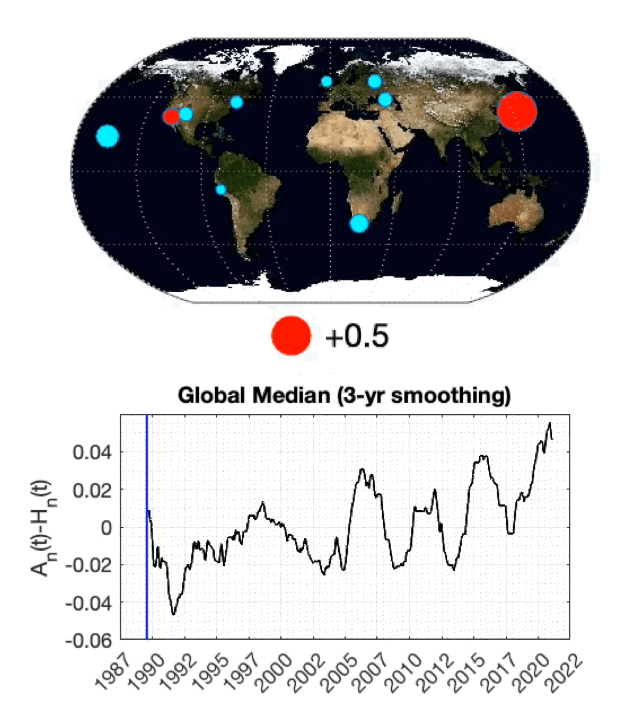AP Photo/Kin Cheung" src="https://s.yimg.com/ny/api/res/1.2/tFO8fZiMMEwMv4SgJ3LV9A-/YXBwaWQ9aGlnaGxhbmRlcjt3PTk2MDtoPTYzMg-/https://media.zenfs.com/en/the_conversation_us_articles_815/0cce3be9a3a1bbe 769d68620228ca588″ data-src= "https://s.yimg.com/ny/api/res/1.2/tFO8fZiMMEwMv4SgJ3LV9A-/YXBwaWQ9aGlnaGxhbmRlcjt3PTk2MDtoPTYzMg-/https://media.zenfs.com/en/the_conversation_us_articles_815/0cce3be9a3a1bbe769d 68620228ca588″/>
As the waves of the oceans rise and fall, they exert forces on the seafloor below and generate seismic waves. These seismic waves are so powerful and widespread that they appear as a steady rumble on seismographs, the same instruments used to monitor and study earthquakes.
That wave signal has become increasingly intense in recent decades, reflecting increasingly stormy seas and higher ocean swells.
In a new study in the journal Nature Communications, colleagues and I tracked that increase around the world over the past four decades. These global data, along with other seismic surveys of oceans, satellites and regional areas, show a decades-long increase in wave energy coinciding with increasing storminess attributed to rising global temperatures.
What seismology has to do with ocean waves
Global seismographic networks are best known for monitoring and studying earthquakes and for allowing scientists to image the deep interior of the planet.
These highly sensitive instruments continuously record a huge variety of natural and man-made seismic phenomena, including volcanic eruptions, nuclear and other explosions, meteor impacts, landslides and glacial quakes. They also pick up persistent seismic signals from wind, water and human activity. For example, seismographic networks observed the global silence in man-made seismic noise as lockdown measures were imposed around the world during the coronavirus pandemic.
However, the most globally pervasive seismic background signal is the incessant rumbling caused by storm-driven ocean waves, known as global microseism.
Two types of seismic signals
Ocean waves generate microseismic signals in two different ways.
The more energetic of the two, known as secondary microseism, beats with a period between about eight and fourteen seconds. As sets of waves travel in different directions across the oceans, they interfere with each other, causing pressure variations on the seafloor. However, interfering waves are not always present, so in that sense it is an imperfect proxy for overall ocean wave activity.
The story continues
A second way in which ocean waves generate global seismic signals is called the primary microseism process. These signals are caused by moving ocean waves that push and pull directly on the seabed. Because water movement within waves decreases rapidly with depth, this occurs in areas where the water depth is less than about 1000 feet (about 300 meters). The primary microseism signal is visible in seismic data as a constant hum with a period between 14 and 20 seconds.
What the vibrating planet tells us
In our study, we estimated and analyzed historical primary microseism intensity until the late 1980s at 52 seismograph sites around the world with a long history of continuous recording.
We found that 41 (79%) of these stations showed a very significant and progressive increase in energy over the past decades.
The results indicate that global average ocean wave energy has increased by an average of 0.27% per year since the end of the 20th century. However, since 2000, the global average rate increase has increased by 0.35% per year.

We found the largest total microseism energy in the very stormy regions of the Southern Ocean near the Antarctic Peninsula. But these results show that North Atlantic waves have intensified most rapidly in recent decades compared to historical levels. That's consistent with recent research suggesting that the intensity of North Atlantic storms and coastal hazards are increasing. Storm Ciarán, which hit Europe in November 2023 with powerful waves and hurricane winds, was an example of this.
The decades-long microseismus record also shows the seasonal changes of strong winter storms between the Northern and Southern Hemispheres. It captures the wave-dampening effects of the growing and shrinking Antarctic sea ice, as well as the multi-year highs and lows associated with the El Niño and La Niña cycles and their long-range effects on ocean waves and storms.
Together, these and other recent seismic studies complement results from climate and ocean research showing that storms and waves are increasing as the climate warms.
A coastal warning
The oceans have absorbed about 90% of the excess heat associated with rising greenhouse gas emissions from human activities in recent decades. That excess energy can translate into more damaging waves and more powerful storms.
Our results provide another warning for coastal communities, where increasing ocean wave heights could pound coastlines, damage infrastructure and erode land. The consequences of increasing wave energy are exacerbated by continued sea level rise, fueled by climate change and land subsidence. And they emphasize the importance of mitigating climate change and building resilience in coastal infrastructure and environmental protection strategies.
This article is republished from The Conversation, an independent nonprofit organization providing facts and trusted analysis to help you understand our complex world. The Conversation has a variety of fascinating free newsletters.It was written by: Richard Aster, Colorado State University.
Read more: Richard Aster receives funding from the US National Science Foundation.